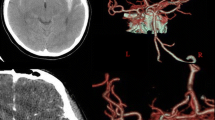Abstract
Diagnosis of an intracranial aneurysm during pregnancy is a rare event requiring multidisciplinary care for successful management. The knowledge base for the anesthesiologist involves principles of both obstetric and neuroanesthesia, as well as critical care. This article reports such a case and discusses the relevant pathophysiology, along with details of the perioperative management by the anesthesiology team.
Similar content being viewed by others
References
Stehbens WE. Aneurysms and anatomic variations of cerebral arteries. Arch Pathol 1963;75:45.
Sarti C, Tuomilehto J, Salomaa V, et al. Epidemiology of subarachnoid haemorrhage in Finland from 1983 to 1985. Stroke 1991;422:848–853.
Tidswell P, Dias MS, Sagar HJ, et al. Cognitive outcome after aneurysm rupture: relationship to aneurysm site and perioperative complications. Neurology 1995;45:875–882.
Singer RI, Ogilvy CS, Rordorf G. Intracranial aneurysms. Up To Date vol 12 No 1: www.uptodate.com.
Teunissen LL, Rinkel GJ, Algra A, Van Gijin J. Risk factors for subarachnoid haemorrhage: a systematic review. Stroke 1996; 27:544–549.
Knekt P, Reuanen A, Aho K, et al. Risk factors for subarachnoid haemorrhage in a longitudinal population study. J Clin Epidemiol 1991;44:933–939.
Leppala JM, Paunio M, Virtamo J, et al. Alcohol consumption and stroke incidence in male smokers. Circulation 1999;100:1209–1214.
Miller HJ, Hinkley CM. Berry aneurysms in pregnancy: a 10 year report. South Med J 1970;63:279.
Dias MS, Sekhar LN. Intracranial haemorrhage from aneurysms and arteriovenous malformations during pregnancy and the puerperium. Neurosurgery 1990;27:855–865.
Barrett JM, Van Hooydonk JE, Boehm FH. Pregnancy related rupture of arterial aneurysms. Obstet Gynecol Surv 1982;37:557–566.
Barro A, Freeman DW. Maternal deaths due to spontaneous subarachnoid haemorrhage. Am J Obstet Gynecol 1976;125:384–392.
Stoodley MA, MacDonald RL, Weir BK. Pregnancy and intracranial aneurysms. Neurosurg Clin N Am 1998;9:549–550.
Witlin AG, Friedman SA, Egerman RS, Frangich AY, Sibai BM, Cerebrovascular disorders complicating pregnancy: Beyond eclampsia. AM J Obstet Gynecol 1997;176:1139–1148.
Dovey Z, Misra M, Thornton J, et al. Guglielmi detachable coiling: the story so far. Neurological review 2001;58:559–564.
Lai YC, Manninen PH. Anaesthesia for cerebral aneurysms: a comparison between interventional neuroradiology and surgery. Can J Anaes 2001;48:391–395.
ISAT collaborative group. International subarachnoid haemor rhage trial of neurosurgical clipping vs. endovascular coiling in 2143 patients with ruptured intracranial aneurysms: a ran domised trial. Lancet 2002;360:1267–1274.
Singer RJ, Ogilvy CS, Rordorf G. Treatment of subarachnoid Haemorrhage. Up To Date vol 12 No 1: www.uptodate.com
Meyers PM, Halbach W, Malek AM, et al. Endovascular treatment of cerebral artery aneurysms during pregnancy: a report of 3 cases. Am J Neuroradiol 2000;21:1306–1311.
Gill TE, Mani S, Dessables DR. Anaesthetic management of cerebral artery aneurysm clipping during pregnancy: a case report. J Am Assoc N Anesth 1993;61:232–286.
Macfie AG, Magides AP, Richmond MN, Reilly CS. Gastric emptying in pregnancy. Br J Anaesth 1992;68:115–116.
Gin TO, Meara ME, Kan AF. Plasma catecholamines and neonatal condition after induction of anaesthesia with propofol or thiopentone at caesarean section. Br J Anaesth 1993;70:311–316.
O'Hare R, McAtamney D, Mirakhur R, et al. Bolus dose Remifentanil for control of haemodynamic response to tracheal intubation during rapid sequence induction of anaesthesis. Br J Anaesth 1999;82:283–285.
Kan RE, Hughes SC, Roson MA, et al. Intravenous remifentail: placental transfer, maternal and neonatal effects. Anesthesiol, 1998; 88:1467–1474.
Roecants F, De Fraceschi T, Veychanan F, et al. Patient controlled intravenous anaesthesia using Remifentanil in the parturient. Can J Anaesth 2001;48:175–178.
McCourt KC, Salmela L, Mirakhur RK, et al. Comparison of rocuronium and suxamethonium for use during rapid sequence induction of anaesthesia. Anaesth 1998;53:867–871.
Abouleish E, Abboud T, LeChevalier T, et al. Rocuronium (ORG9426) for caesarean section. Br J Anaesth 1994;73:336–341.
Newman B, Lam AM. Induced hypotension for clipping of a cerebral aneurysm during pregnancy. Anesth Analg 1986;65:675–678.
Levinson G, Schnider SM, Delorimer AA, Steffenson I. Effects of maternal hyperventilation on uterine blood flow and fetal oxy genation and acid base balance. Anesthesiol 1974;40:340–347.
Metoyama EK, Rivard G, Acheson F. The effect of changes in maternal pH and carbon dioxide on the pO2 of fetal lambs. Anesthesiol 1967;28:891–903.
Shaker K, Amir M, Shiman NA. Uterine contractions due to heparin. BMJ 1974;5941:408–409.
Kizilkilic O, Albayram S, Adaletei I, et al. Endovascular treatment of ruptured intracranial aneurysms during pregnancy: report of three cases. Arch Gynecol Obstet 2003;268:325–328.
Ahmeda F, Schaer G. Noncardiac applications of Gp IIb/IIIa inhibitors. Catheterization and cardiovascular interventions. 2002;62:530–538.
Perez-Arjana E, Fessler R. Basilar artery and bilateral posterior cerebral artery Y stenting for endovascular reconstruction of wide necked basilar apex aneurysm—report of 3 cases. Neurol Res. 2004;26:276–281.
Author information
Authors and Affiliations
Corresponding author
Rights and permissions
About this article
Cite this article
Allen, G., Farling, P. & McAtamney, D. Anesthetic management of the pregnant patient for endovascular coiling of an unruptured intracranial aneurysm. Neurocrit Care 4, 18–20 (2006). https://doi.org/10.1385/NCC:4:1:018
Issue Date:
DOI: https://doi.org/10.1385/NCC:4:1:018




